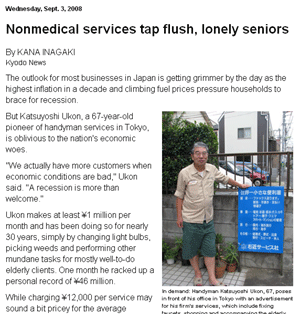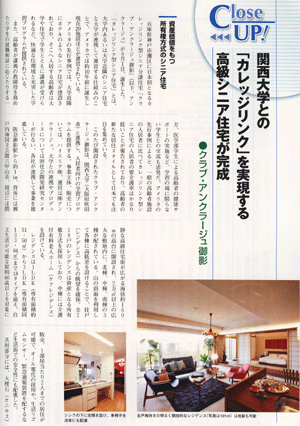Prime 2008年9・10月号(シンガポールの専門誌)
With the ageing population set to grow, reaching out to the senior population with products designed to help them live better lives is on designer’s minds. A well-known expert on the senior’s market, Dr. Hiroyuki Murata, gave his take at a seminar on designing for the ageing population held by Temasek Polytechnic’s >60 Design Centre: “The best way to predict the future is to invent it.”
The president of Murata Associates and author of The Business of Aging: 10Successful Strategies for a Diverse Market said that we first need to abolish stereotypes and myths regarding the elderly. For instance, elderly does not mean disabled. More importantly, age-friendly design is different from what the terms “ageing-friendly” design. While the former refers to design that is targeted at specific age groups based on what appeals to them, the latter is design that co-evolves between designers and ageing users.
AGEING-FRIENDLY DESIGNS
To illustrate his point, Dr. Murata cited examples from Japan. For instance, the Raku-Raku Phone (or easy-easy phone) from NTT DoCoMo features larger text and larger buttons, as well as a function that reduces talk speed. The last is especially useful as the elderly tend to experience hearing loss. Invented 10 years ago, the Raku-Raku Phone has sold more than 13 million units to date. Following on from the success of the Raku-Raku, the company came up with the Raku-Raku Phone Simple, which featured basic functions thought to appeal to seniors due to their ease of usage. This, however, did not do as well. Yet subsequent phones the company packed with premium functions such as a pedometer did really well. This is because “the elderly are more sophisticated customers,” said Dr. Murata.
A SOPHISTICATED MARKET
Another case in point is a chain of fitness clubs called Curves, targeted at women aged 50 and above – an idea Dr. Murata picked up when he was in the US. “There are no mirrors in the gyms as the women don’t want to see themselves,” said Dr. Murata. “The workouts are also short and easy, and the clubs are located close to their homes.” As a result, what began as a small outfit of three clubs has grown into a flourishing nationwide chain of 658. As Dr. Murata put it, “Ageing-friendly service must be fun and enjoyable. The elderly don’t want strict training.” Dr. Murata then cited examples from the fashion industry. A brand called Tensel is particularly popular with women in their 50s because their clothes cover the loose flesh of the neck, an area older women are often self-conscious about. Their clothes are also easy to wear and to remove, plus are machine washable. Most important of all, while the clothes are functional, they’re also stylish. That’s why “you need to listen to the voice of the market and the people,” said Dr. Murata.
DESIGNER LIVING
Another area that is often overlooked when it comes to senior citizens is public housing. While more thought has always gone into the design of such housing in Japan – witness the existence of fewer barriers such as the stairs, and the presence of assistive services and care facilities ? these apartments often resemble a sterile hospital with their white walls. Now, however, things are changing dramatically. Dr. Murata is involved in Club Encourage Mikage, a senior housing project operated by Encourage, Inc., in collaboration with Kansai University. Not only are these apartments located in an upscale area, they also feature panoramic sea views and stylish Italian architecture. Better yet, the cafeteria serves Japanese and French-inspired cuisine in small, senior-friendly portions as the elderly tend to have smaller appetites. Other facilities include a fancy swimming pool and a hot spring bath. Furthermore, unlike other retirement housing projects, Club Encourage Mikage is based on an equity model rather than an entry fee or a monthly fee model. In other words, each resident owns a piece of the property – but at a price. A 66㎡ room and part of the common area (about 42 percent of the total area) costs 78 million yen(S$l, 005,402) – excluding monthly expenses such as food and utilities. The bigger 140㎡ rooms plus common area cost 130 million yen(S$l, 677,200). Very importantly, such retirement projects are open to purchase only by those aged above 60. If a resident passes away, the property may be inherited by the next-of-kin, but the latter would have to rent them out to someone who meets the age criterion.
MEETING OF THE MINDS
Interestingly, the housing is “college linked” to Kansai University, which means residents can go over to learn with the young students (Note: the university also accepts non-residents). Dr. Murata comments that this is because “human beings derive the greatest joy from learning. It is the ultimate ‘preventive medicine’ free of pills.” He adds, “Ageing-friendly service must be inter-generational. It shouldn’t focus just on the elderly. Social interaction is key to success!” Next to speak at the seminar was designer and professor Ron Nabarro, founder and director of innovation by Design and cofounder and president of Senior-Touch: “When people grow older, self-esteem, identity and well-being are deeply dependent on their ability to function around their physical surroundings with a sense of comfort, independence and dignity. The results of a survey on the problems older people face in their day-to-day life indicated that more than 50 percent of them could potentially be addressed through better design.” Unfortunately, professor Nabarro remarked, “The designers are often younger than the customers they are designing for, which means they don’t have any understanding of what it means to be 80 years old.” He went on to explain the concept of ageing: “Old is when men and women begin to see their lives in terms of ‘time left’ rather than ‘time since birth’.” He also noted that baby boomers who are now turning 60 know much more about ageing than previous generations, as they’ve watched their own parents growing old ? all the move reason for designers to stay on their toes.





